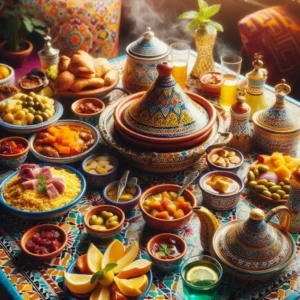Moroccan cuisine boasts a rich heritage, with Moroccan couscous standing out as a national dish par excellence. It is nearly impossible to mention Moroccan dietary habits without bringing up couscous. Visitors to Morocco, both past and present, frequently encounter the widespread popularity of this dish among Moroccans of all social classes. No Moroccan table, whether in urban or rural areas, is complete without a serving of couscous at least once a week, especially on Fridays. Despite changes in Moroccan eating habits due to fast-paced lifestyles and the rise of dining out, couscous has retained its revered position as a staple of Moroccan cuisine.
Origins of Moroccan Couscous
Couscous has been known since at least the early Middle Ages, with its origins tracing back even further to ancient Berber culture. Ibn Khaldun, a renowned historian, noted that when Berbers were asked about their identity after the Islamic conquest of Morocco, they replied, “We are a people who shave our heads, wear the burnoose, and eat couscous.” These elements, including couscous, have been highlighted by travelers visiting Morocco throughout various historical periods.
The name “couscous” itself is derived from Berber language, with variations such as ‘asuksu,’ ‘seksu,’ ‘ufti,’ ‘arwai,’ ‘adnbo,’ and ‘achink.’ It is also referred to as “utchi” or “utcho,” meaning food, as it is the staple food of the Berbers. The verb forms ‘iksks’ or ‘isksu’ mean to make couscous, and ‘couscoussier’ is the pot used to steam couscous over a pot of stew.
Preparation and Cooking
In the 13th century, the Moroccan-Andalusian cookbook “Fudala al-Khiwan fi Tayyibat al-Ta’am wa al-Alwan” by Ibn Razin al-Tujibi (d. 1292) elaborates on couscous preparation. The book describes the process of making couscous by moistening semolina with salted water, gently rubbing it with the fingertips, and then sifting it to separate the grains. The grains are steamed over a stew of meat and vegetables in a couscoussier until they are tender and flavorful. This traditional method of preparation has been passed down through generations, preserving the authenticity of Moroccan couscous.
Is Couscous Exclusively Moroccan?
While couscous is a common dish across North Africa, it is strongly associated with Morocco due to its global popularity and the unique Moroccan methods of preparation and presentation. Moroccan cuisine is often seen as a symbol of Moroccan hospitality and culinary excellence. The frequent presence of couscous on Moroccan tables, whether during regular Fridays or special occasions, highlights its importance in Moroccan culture.
Morocco, alongside Algeria, Tunisia, and Mauritania, successfully registered the “skills, knowledge, and practices related to the production and consumption of couscous” on UNESCO’s list of Intangible Cultural Heritage in December 2020. Additionally, Morocco has listed the skills and customs related to Moroccan couscous on the ISESCO (Islamic World Educational, Scientific, and Cultural Organization) heritage list.
Varieties of Moroccan Couscous
The types of couscous prepared in Morocco vary by region and social class. Simple couscous, which might include only water, oil or fat, onions, and salt, is typically made with a coarse mixture of flour and bran known as “hamra” in rural Moroccan dialect. This basic version, once common among poorer communities, is known by different names across regions.
In contrast, “couscous with seven vegetables” is a richer and more flavorful dish made with fine semolina, meat, and a variety of vegetables and spices. Another popular variant is “tfaya,” which includes sweet caramelized onions, raisins, chickpeas, and mutton. Additionally, couscous made with barley semolina and often served with head meat (beef or sheep) is another traditional type. “Abladaz,” made with corn semolina, is yet another variation.
Another form of couscous is “sikouk” or “azikouk,” made with wheat, barley, or corn semolina soaked in sour milk, commonly eaten in rural areas during summer. A larger-grained version, “barkoukch” or “abarkoukch,” is served with milk and melted butter. “Sefa” is a sweet version of couscous, steamed multiple times, mixed with butter, and garnished with powdered sugar and cinnamon.
The traditional preparation of couscous involves steaming the grains several times over a pot of stew, with the best results achieved by steaming three to four times. This meticulous method ensures that the couscous is fluffy and flavorful, retaining its rightful place at the heart of Moroccan cuisine.




